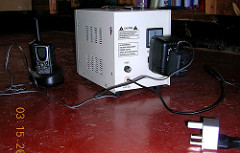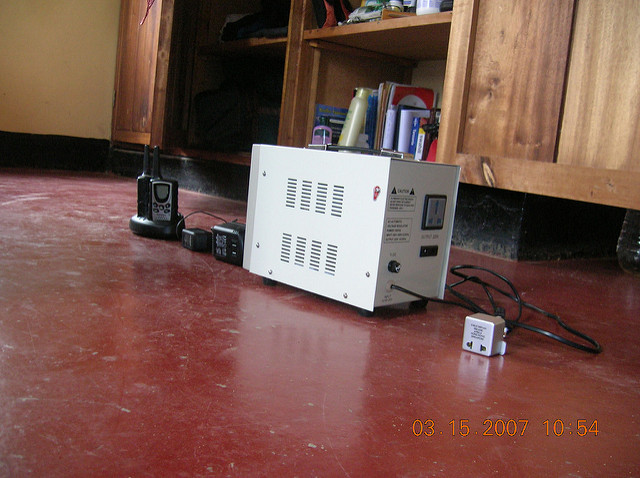Electricity in Tanzania

Plugging appliances in Tanzania is not as straightforward as one may think. During this my stay, I have polished my knowledge quite a bit. Firstly, I will introduce what kind of electric system is set up in Tanzania. I will then lay out case studies about two different appliances that I brought from the US.
Disclaimer: I am not an electrician, so the coming advices and observations may be inaccurate. Do not blame me if your appliance gets toasted by following my advices.
The electrical outlets are identical to the ones used in the United Kingdom: two thick rectangular prongs plus a ground prong. I suppose that it is one of the legacies of English colonization (driving to the left side of the road would be another one). In continental Europe, the plug is made up of two thin circular prongs. Finally, in the US/Australia, the prongs are shaped as thin easily-bendable rectangles. Therefore, having a plug adapter is a must-have for travelers bringing appliances from their home countries. However, plug adapters is not the only thing to take into account when plugging electrical appliances.
Travelers also need to take voltage into consideration. The world uses 220V, the major exception being the USA where 110V is the norm. Hence, plugging an appliance designed for a 110V input to a 220V grid will toast the appliance in all likelihood (over voltage). However, plugging a European appliance (designed for a 220V input) in the US will not harm the appliance, but will not make it work either (under voltage). In conclusion, having solely a plug adapter is not sufficient. You also need to purchase either a step-down converter (transform 220V to 110V) or a step-up converter (transform 110V to 220V). A step-down converter is not too expensive; I purchased mine for 25€.
Some appliances, such as laptops, have been designed to receive either 110V or 220V input. It makes sense since laptops are meant to be taken anywhere in the world. Other appliances, such as specific AA battery chargers, are also designed to be “travelers friendly”. Before buying, always look for the input specifications written on the appliance. If you see “INPUT: 110V – 220V”, you are good to go. If you see “INPUT: 110V”, buy a step-down if your country of destination works with 220V.
As a developing country, the availability of the electricity in Tanzania is a little bit sketchy at best. Right now, we are experiencing one power outage at least once a day. Wind and rain are likely to increase the risk of such outages. But luckily enough, the outages do not last very long where we live (around thirty minutes). The electricity is produced by a dam west of Arusha. Heavy rains have filled out the lake, and the dam should be able to produce electricity on a continued basis until the beginning of the dry season. It is hence recommended to obtain a surge protector such as an APC pack for your computer. It will avoid some frustrations and head banging on the wall.
Power outage is also coupled with power surges. Because the infrastructures are quite poor, the voltage cannot be stabilized to 220V. Hence, it can fluctuate below and above. Under voltage is not a big problem, but over voltage can destroy the powered up appliances. That is why it is recommended to protect appliances with power surge protectors and voltage regulators.
Exercise 1
Now that you know a little bit more about power supplies in Tanzania, let’s have some practical exercises. Here, we assume that a voltage regulator is available and was designed for European outlets. The output outlets can adapt to any plug. For each test case, list the other required equipments and describe how they need to be set up.
The battery of a laptop brought in the US needs to be charged. On the AC adapter of the laptop, the following is written:
- Input: 100-240V 2.4 A – 50/60Hz
- Output: 18.5V – 4.9A – 90W
Let’s step it a notch with another exercise.
Exercise 2
Two volunteers have brought a pair of walkie-talkies from the US. The batteries of these walkie-talkies needs be charged up. On the AC adapter, the following is written:
- Input: AC 120V 60 Hz 4W
- Output: DC 9V 210 mA
Answers
These are the components from the outlet to the appliance. For the laptop:
- Plug adapter from UK to Europe
- Voltage regulator
- Laptop AC adapter
- Laptop
For the walkie-talkies:
- Plug adapter from UK to Europe
- Voltage regulator
- Step-down converter
- Walkie-talkie AC adapter
- Walkie-talkies
